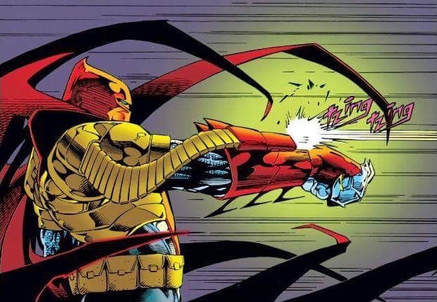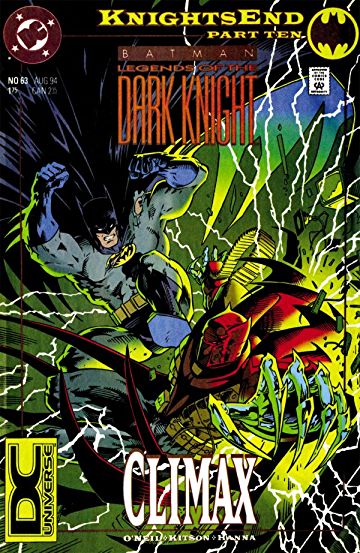Written by Joel T. Lewis'Batman: Legends of the Dark Knight' #63 - 'KnightsEnd Part 10: Climax' Of all the comics books I’ve ever owned, this is the one I’ve read the most frequently. It’s my favorite comic book. Of all time. And it’s not a Moon Knight comic. This is the epic conclusion of one of the most contentious comic book events of all time, the aftermath of Bane breaking Batman’s back (try saying that five times fast), the passing of the mantle to Jean Paul Valley, the disturbed young man conditioned from before birth to become Azrael the Avenging Angel, and Bruce Wayne’s recovery and return to reclaim his dark twisted crusade from the overzealous violent claws of his unworthy successor. I know all this now, but thumbing through the pages of this comic for the first, second, even the 50th time I had no idea the depth of the story that came before, the controversy that surrounded it, or the significance of Bruce reclaiming the mantle in this issue. Now I don’t know which came into my life first, this issue or the action figure inspired by it, but perhaps my affection for this comic, the Azbat suit, and the man inside it came from owning both the comic and my Ultra Armor Batman figure, which remains to this day one of my most prized possessions. I don’t know if I made this connection at the time, but certainly looking back on it now, to see the wackiness and diversity of Batman’s action figures mirrored in the pages of a comic book, to see that my toys had come from actual stories, made a big impact on me. Forget Woody and Buzz in Toy Story, Ultra Armor Batman had some demons. Now let’s get into the issue. It doesn’t waste any time readers. On pages 1 and 2 we see a gleaming, red, gold, and silver thing, claiming to be Batman, but more than that, claiming that Wayne Manor is his house, that being Batman is a privilege, and that Bruce Wayne doesn’t deserve to be Batman. These are the first two pages! This issue serves as the very bedrock of my fascination with Batman and his world and it directly challenges so much of the quid pro quo of that world in its first breath. From the jump there’s this idea of the mantle of the bat, of uncertainty over who it belongs to, and the twisted logic of Jean Paul who sees the mantle as a privilege, a calling to be coveted, rather than the traumatic burden that it is to Bruce. Valley then pontificates over the big highlights of the ‘KnightFall’ event referring back to Bane breaking Batman, Bruce passing on the mantle, and then running from the Bat’s Crusade. Valley then breaks the portrait of Thomas Wayne over his knee, (in a panel that I didn’t know at the time mirrored Bane’s treatment of Bruce so many issues earlier) and tears through the deceased patriarch’s face, in a dramatic visual representation of Batman being born out of the destruction of Thomas and Martha Wayne, but also of the terrible nature of Batman, of his potential for violence, cruelty, and malice as a construct separate from Bruce. The idea that Batman could exist as a separate entity, and the terrible potential for that creation without Bruce to balance it just leaps off the page. Batman proceeds to pursue Valley into the Batcave, but not through the constructed, booby-trapped avenue he himself set in place, but through the very hole he fell through as a child, where his own fear of bats, and his consequent taking the bat as his symbol began. The conflict, the madness of Jean Paul Valley, and the desperation with which he clings to his borrowed identity as Batman was not lost on me as a child, though his references to St. Dumas, and the ghost of his father went right over my head. Valley lashes out, tearing through the emblem on Bruce’s chest, a mirror of the damage he’s done to the legacy of the Batman, but even as he lashes out he screams into the chilled, quiet air of the Batcave, ‘I am Batman...because if I am not...I am Nothing!’ Bruce leads Valley through the winding labyrinth of the cave, knowing that the ever-narrowing cavern will force him to cast off the bulky, technological trappings of his techno-future batsuit, and allow Bruce to take him down man to man. And as Valley descends into the dark womb that birthed the Batman he faces Bruce stripped of all of the Batsuit save the cowl. Bruce blinds Valley by removing the baffle set in place by his father to cover the hole he fell through so many years ago bathing himself and his unworthy successor in the light of the new dawn. Valley removes the cowl and sees the truth that he is not truly Batman and Bruce lifts them both out of the cave into the light and as the issue ends, the mantle is no longer in contention, and the Bat stands in the sun.  In many ways, this was my introduction to the origin of Batman. Bruce’s descent into the Batcave to reclaim the mantle from Jean Paul, and the claustrophobia and failure of Valley trying to descend into that dark birthing place, almost tell the origin of Batman better than the issues in which he first appeared. In this we see the growth of Batman, the deeper understanding of the man and his mantle, and the realization in Bruce that passing his crusade over to another, especially one so ill-prepared, was cruel. This shaped my understanding of the mantle of Batman and it tempered what might have been outrage at someone else taking on the cape and cowl because I’d seen it done before, and loved the twisted complexity of that dynamic. More than that, it fostered in me a fascination for the dynamics of the Bat-Family, for the twisted wheel of trauma that Batman’s crusade created and how it affected those pulled into its influence. I had the sense that other people could step into this world, even into the role of Batman, and that it would drastically reshape them, for good or ill. Let’s talk about Jean Paul Valley. It’s not an exaggeration to call him on of the most controversial comic book characters of all time. Despite all his faults, the negative reception of his suit, his line-jumping in taking over Batman’s mantle, the vague and confusing nature of his origin and the ‘system’ designed by the Order of St. Dumas that plays so large a role in his story, I have always loved this character. As a kid it was mostly aesthetic. The Azrael Batman (or AzBat) costume is just cool. In many ways the 90’s were about excess (I mean look at the number of subtitles for this issue) and this suit is no exception. The earlier appearances of the suit sported a blue, gold, and black color pallet, but in my opinion the red and gold suit has no equal. Claws? Check. Arm Rockets? Check. Curled chain magazines full of Batarangs? Check. It’s got spikes, it looks good in motion, and it steals the show in every panel it’s in. This red suit only appears in one other issue, Detective Comics #677 and in my opinion it doesn’t measure up. The detail, the shine, and the color of that suit brought to life by the combination of artist Barry Kitson and colors by the talented team at Digital Chameleon is something I’ve not seen since. Separate from the look, Jean Paul Valley represents a difficult and bold move in the history of Batman. This was the first successor to Batman, uncharted territory, and in many ways something that could not be well received by its very nature. How do you give the mantle to Nightwing, a character that had spent so much time establishing his legitimacy in his own title, in a new city, with his own rogue’s gallery? I feel like if they had gone in that direction, (which they eventually did in the ‘Prodigal’ arc which I will discuss in part 2 of this series) with the stakes as high as they were with Bane and the rest of the rogue’s gallery in play it could have undermined all the work that went into establishing Nightwing as his own man, as an independent and legitimate superhero. In many ways, that storyline required an expendable, transitionary character, someone who could be written in for a while, and written out just as quickly, and while Jean Paul fit that criteria, he managed to (despite his role as the hyper-violent 90’s techno Batman) be relatable and sympathetic in the end. His uncertainty in his identity, the manipulation of his mind, and the journey he is set upon following his tenure as Batman have cemented him as one of the great tragedies of the Bat-family, but also one of the triumphs in my opinion. The artwork in this book is breathtaking. There is an immediacy to this issue, a sharpness that has stuck with me, and informs my expectations for what comic book art can be and what it can do to this day. The detail, the execution of facial expression, and the weight of those action panels live so vividly in my memory that they serve as my template, my measuring stick for a Batman comic. The sequence of Valley descending into the narrow tunnel where Bruce fell so many years ago is so simple and effective: the jagged and bulky silhouette of the AzBat suit crouching and then crawling down this decrescendo of a tunnel conveys the weight of that suit, the closeness of the air in that tunnel, and the panic of feeling trapped in the darkness under the earth all at once. This is the issue that defined how Batman looked in my mind; how he moved, the way his face contorted as he landed a punch or took one himself, the metal of the man behind that mask, but also the compassion there as well. I was never content not knowing the story that led up to this final showdown. Before I ever scoured a long box in search of Moon Knight appearances, I tracked down the 3 volumes of the ‘KnightFall’ event. I scraped together allowances and birthday money to buy each one separately, devoured them and had to wait in narrative agony until I had enough to buy the next one. This was the first story I tracked down, and my first (and ultimately the most satisfying), sense of closure with a comic storyline. In the next chapter of my comic book origin story I’ll take a look at another issue where the man under the cowl isn’t Bruce Wayne, Batman #514. Until Next Time, Geek On!
0 Comments
Leave a Reply. |
Archives
May 2024
|
|
© 2012-2025, Nerds That Geek LLC.
All Rights Reserved. |
uWeb Hosting by FatCow
